What Is Data Roaming Explained: Avoid Extra Costs

Introduction
During my last trip, I found myself happily unaware of the concept of cellular data roaming. However, it wasn’t until I returned home to a staggering bill that I realized the gravity of my oversight.
I was shocked by the unexpected charges, so I started to investigate, determined to discover what is data roaming. Through trial and error, and a few costly lessons abroad, I’ve collected some information.
And now, armed with firsthand experience, I’m excited to share with you all the mysteries of data roaming, its different significances, how to manage it on Android and iPhone devices, savvy strategies, and extra advice to avoid exorbitant charges.
what is cellular data roaming?
To answer the question “What is data roaming?” I will give you a simple explanation: it’s the process of connecting your phone to another network when you are outside your carrier’s service area. It can be while you are abroad or when you are in the country but located outside of your carrier range.
The visited network can have a roaming agreement with your carrier, and your phone can use its services, much like your guests use Wi-Fi at your house. This ensures that you can still make calls, send messages, and use the internet – albeit at potentially different rates than your usual plan.
How Data Roaming Works
When your smartphone is on your home network, it connects to nearby cell towers owned by your carrier to access services. However, if you travel outside their range – let’s say on a business trip or a vacation – your phone still seeks out signals from other available networks, so this is where data roaming comes into play.

Now that we know its meaning let’s check how we can manage it on iPhone and Apple devices.
What is data roaming on iPhone?
When your iPhone allows you to use services requiring internet by connecting to another carrier’s network when you are outside your current network area.
However, you should be aware that using data roaming may result in extra charges from your home carrier. That’s why I will teach you how to adjust this feature on your device at your leisure.
How To Turn Off Data Roaming on iPhone?
Turning off data roaming on your iPhone is a simple process to ensure you do not incur data roaming charges, and here’s how to disable it:
- Go to ‘Settings‘ on your home screen.
- Tap on the option ‘Cellular’ or ‘Mobile Data’.
- Select ‘Cellular Data Options’ or ‘Mobile Data Options’.
- If the data roaming is enabled you will see a green switch, you can off it by taping it. You will know it’s disabled when the switch turns grey or white.
- Now your changes are saved so you can close the ‘Settings’ app.
How To Turn On Data Roaming on iPhone?
The process to turn on the data roaming is similar to the previous one, let’s see how to do it:
- Open ‘Settings‘.
- Go to ‘Cellular’ or ‘Mobile Data’.
- Tap on ‘Cellular Data Options’ or ‘Mobile Data Options’.
- If the data roaming is disabled, you will see a grey or white switch. You can on it by taping it. When the switch is enabled will be green.
- You can close the ‘Settings’ app and your changes are saved.
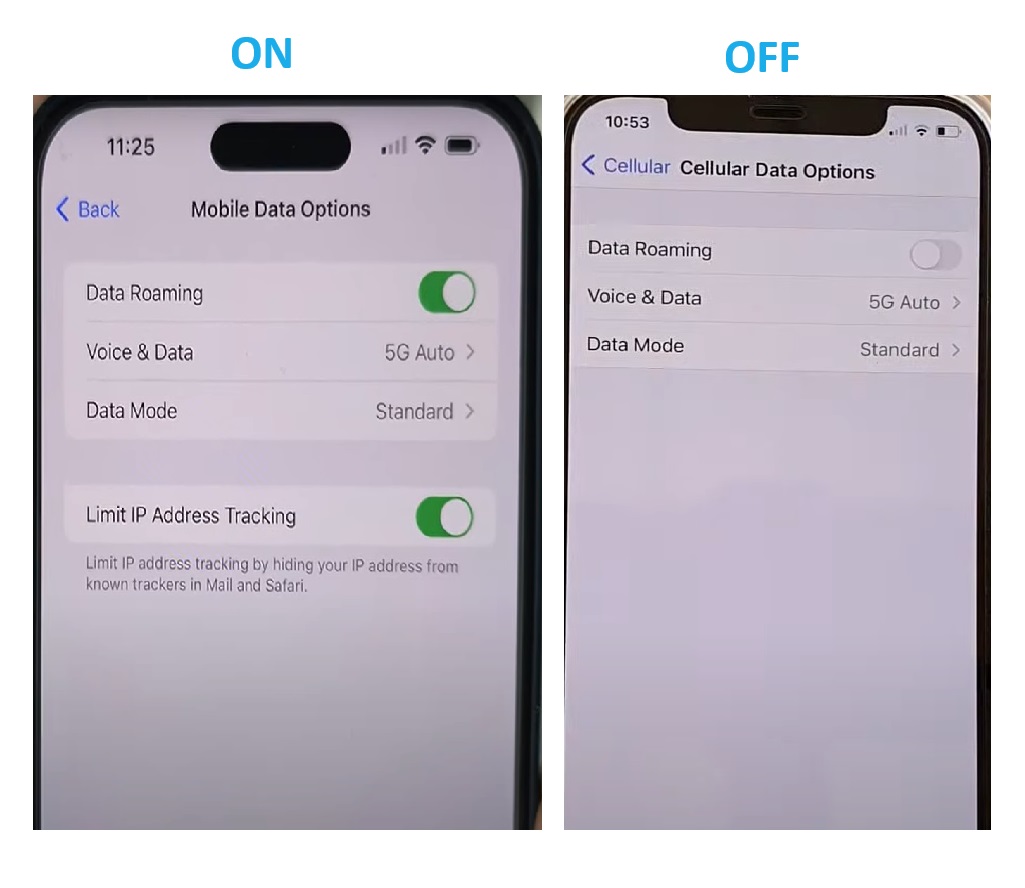
What is data roaming on Android?
Just like the iPhone, data roaming on an Android device allows you to use mobile data using another carrier’s network when you’re outside your network’s coverage.
>>Read more: Find out the detail about what is the data roaming on Android
How to turn on data Roaming on Android?
Here is what you need to enable data roaming on Android:
- Go to Settings.
- Tap on Network & internet or Connections.
- Select Mobile network or Cellular networks.
- Find Data roaming and toggle it on.
- Confirm any warnings about charges.
- You’re set to use cellular data while roaming.
How to turn off data Roaming on Android?
Now let’s disable the data roaming on Android:
- Go to Settings.
- Tap on Network & internet or Connections.
- Select Mobile network or Cellular networks.
- Find Data roaming and toggle it off.
- Confirm any warnings about charges.
- Data roaming is now disabled.
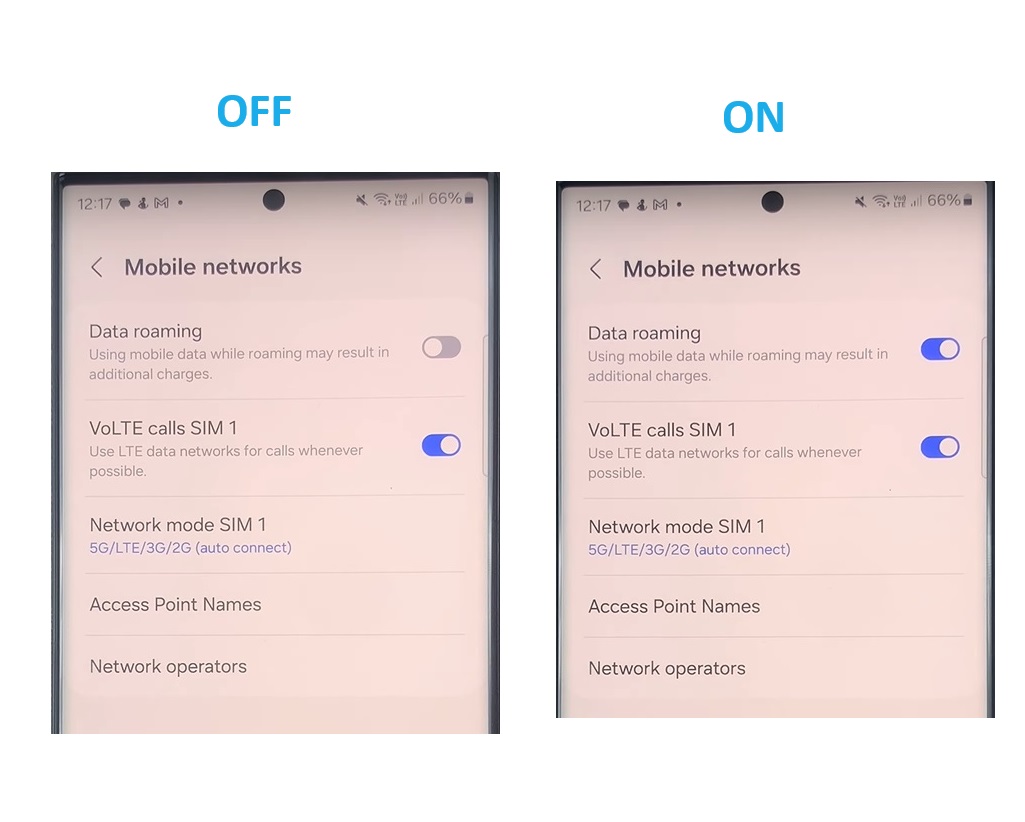
International Roaming vs Domestic Roaming
Other concepts that are crucial for managing costs and maintaining service availability during our travels are international roaming and domestic roaming. Let’s understand them and spot their differences.
Domestic roaming
Occurs when you connect to another provider’s network within your country where your carrier doesn’t have coverage. For example, in our country, carriers may not cover all geographical areas, so they make agreements with other providers to make sure we can still access services. Generally, domestic roaming charges are less likely to apply due to partnerships between carriers or because of large network areas designed to avoid roaming scenarios within a country.
International roaming
It is when you travel abroad, and your phone connects to a network in a different country. Since these networks are operated by foreign companies with whom your home carrier needs to have specific agreements, the cost structures are usually different. It’s common for international roaming rates to be significantly higher because of the involved logistics and agreements between international carriers, which often translate into additional charges to us as the end consumer.
Both domestic and international roaming ensure connectivity, but the implications for service and costs can vary. Therefore, before you travel, it’s important to understand your carrier’s specific policies on roaming to avoid surprises on your bill.
|
|
DOMESTIC |
INTERNATIONAL |
|
Data Usage |
Inside the country |
Abroad |
|
Agreements between your carrier with |
National providers |
Foreign providers |
|
Additional charges |
No |
Yes |
|
Rates |
Included in the standard data plan |
often higher than domestic roaming |
How Much Does Roaming Cost?
Although, understanding your roaming bill can feel like deciphering a secret code, especially if you’re not familiar with certain terminology. I’m here to help you to avoid being caught off guard by high charges, because when you roam the rate is often higher than what you’re charged domestically.

Your roaming bill will list separate charges for each type of service used while roaming. Voice calls are charged per minute, text messages may also have a per-message cost, and data activities are charged per megabyte or gigabyte.
Nevertheless, the major culprit behind a high bill is data. At home, you may be accustomed to using data generously but when roaming using data can become a high-end feature. Things such as social media, streaming videos, or even automatic updates can utilize a significant amount of data unnoticed.
To complicate things further, roaming bills may also include taxes, other service charges, or fees. So, to anticipate costs I recommend reviewing the roaming rates provided by your carrier before traveling.
Now that you understand how a roaming bill works, I have prepared a list of three popular carriers for you to consider for your next trip. Their plan offerings are flexible and competitive, so it’s worth looking at them.
Mint Mobile
Mint Mobile is an MVNO operating on the T-Mobile network that offers prepaid wireless services in the US. Well known for affordable plans featuring high-speed data, unlimited talk, and various data options, it caters to diverse usage needs. Mints offers only three data roaming plans for one, three, and ten days, so maybe it may not be a good alternative if you plan to travel longer.
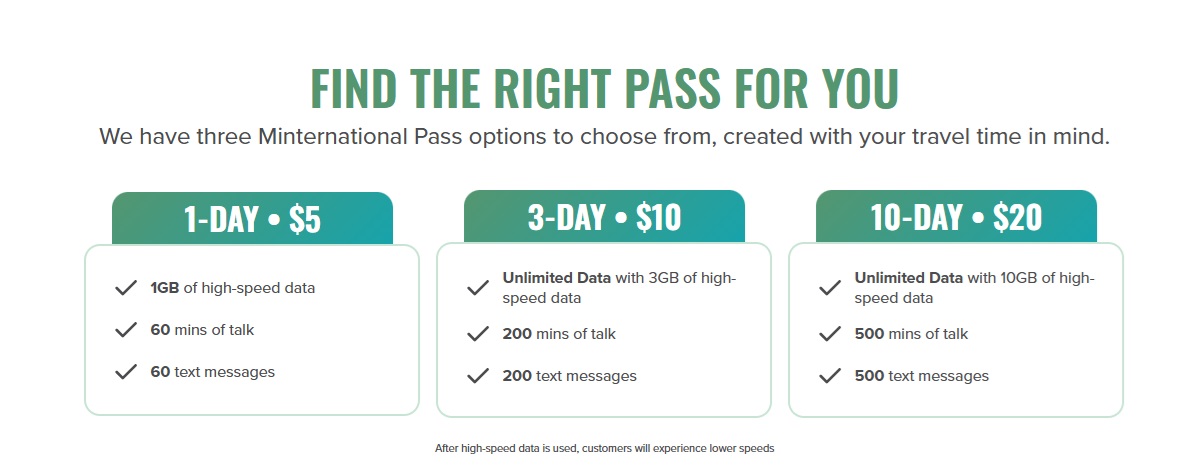
AirVoice Wireless
AirVoice is recognized for its non-contract plans offering us flexibility and affordability. These plans typically feature high-speed data, unlimited talk and text, and various data allowances for different usage needs.
Those looking to travel internationally can take advantage of their pay-as-you-go plans, AirVoice has a straightforward top-up system, with several options for adding credit to your account, including online and through participating retailers. Moreover, as there is no need for a contract you can travel with them anytime you need it.
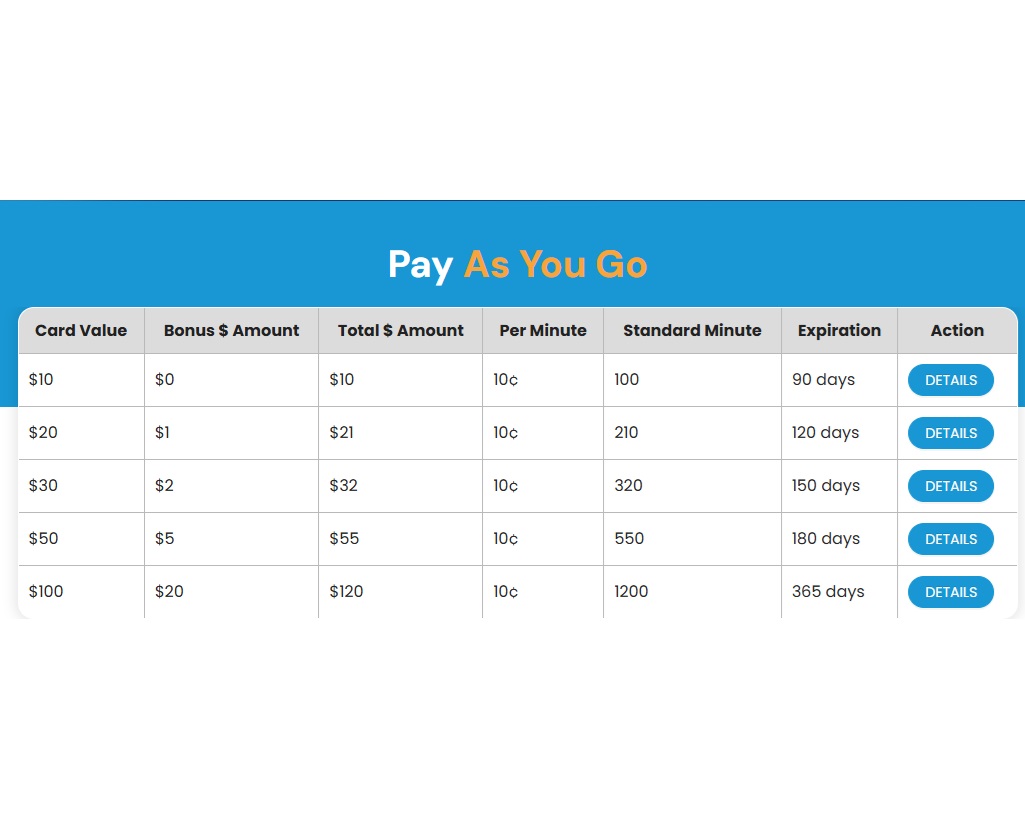
Here are some extra advantages that AirVoice Wireless can offer you both internationally and nationally:
- Affordability: you won’t be tied to long-term contracts.
- Flexibility: offering a variety of customizable plans to fit your needs.
- Nationwide 5+ Coverage: utilizing T-Mobile and AT&T’s networks AirVoice covers over 98% of the US territory.
- International Calling: to over 80+ countries included in all their plans.
- Attentive Customer Service: The company is known for providing helpful customer service via phone, email, and through their website.
- No Hidden Fees: The straightforward pricing of their plans means customers aren’t blindsided by unexpected fees or complicated service agreements.
In addition, I would advise you to directly contact or visit the AirVoice Wireless website by yourself to check their latest roaming offers and associated costs. This can also help you to spot any new deals they may have available.
Pure Talk
Pure Talk operates on the AT&T network and is recognized for its budget-friendly prepaid plans. These plans typically feature high-speed data, unlimited talk and text, and various data allowances. Pure Talk works in 50+ Countries. It offers international credits with their plans, up to 20$.
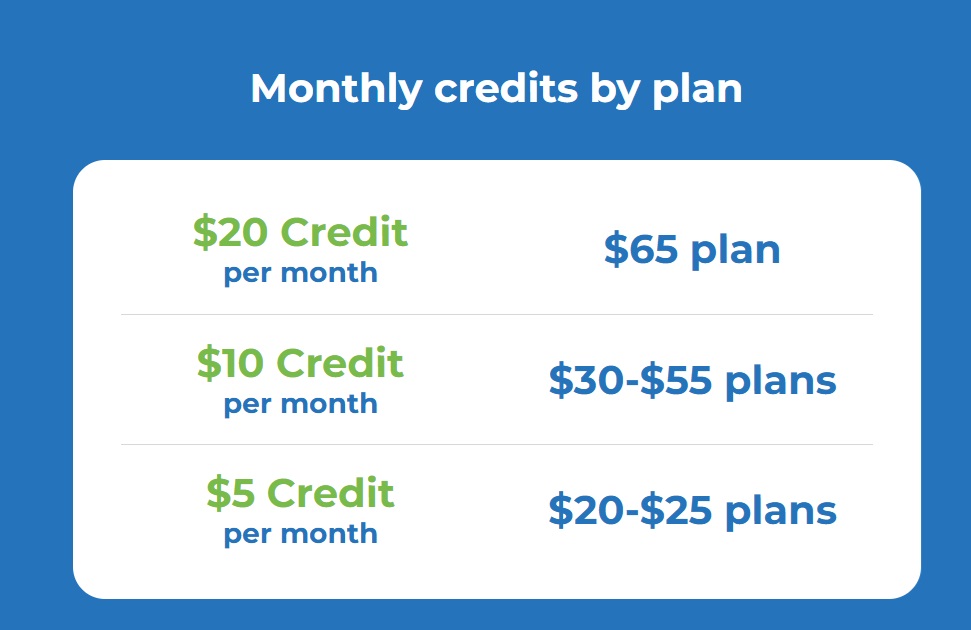
While these carriers aim for simplicity, always verify your plan’s costs and coverage to avoid unexpected expenses or service gaps while abroad.
How to avoid data roaming charges?
As we already said, staying connected while traveling doesn’t have to mean coming home to sky-high phone bills. Here I will share with you extra tips to keep your data consumption in check:
- Monitor Your Data Usage: iPhones and Android devices have built-in data usage trackers on their settings app so you can know which app uses more data.
- Restrict App Background Data: You can change your settings to restrict individual apps from using background data.
- Use Wi-Fi Whenever Possible: At hotels, restaurants, and other public places, but remember to protect your privacy with a VPN when using public networks.
- Disable Automatic Updates and Sync: Turn them off in the settings app until you’re connected to Wi-Fi.
- Download Content Beforehand: While on your home network or Wi-Fi download these before traveling things such as music, videos, or maps. And Use offline modes available in apps like Spotify, Netflix, and Google Maps.
- Utilize Messaging Apps Over SMS/MMS: Avoid SMS and voice services to send messages and make calls, instead try using apps like WhatsApp, Messenger, or Skype using Wi-Fi.
- Set Data Limits and Alerts: Some smartphones let you set a data usage limit or alert to notify you when you’re approaching a certain threshold.
By following my tips, you can minimize your data usage abroad and avoid high roaming charges. Always check with your service provider for international plans or add-ons, which can be more economical than standard roaming charges.
What features should be included in a data roaming plan?
When selecting a data roaming plan, you should look for several key features that will provide both value and peace of mind while traveling. I prepared for you a list with the features to consider:
- Data Allowances: Choose a plan that matches your usage with a generous amount of data. You don’t want to find yourself running out of data midway through your trip.
- Transparent Pricing: Try to always understand the cost of your data roaming plan.
- Network Coverage: Find plans that offer wide network coverage, so you will have access to data services in numerous countries and regions.
- Easy to Activate: Your data roaming plan should be easy to activate before you leave or upon arrival at your destination.
- Affordable Rates for Overages: Even if you are careful, you might still exceed your data limit so look for affordable rates or cost caps.
- Flexibility: Sometimes travel plans change. Try to find a roaming plan that can adapt, with the ability to upgrade or downgrade your data package to your needs.
- Customer Support: Find providers with channels that you can access while abroad, via phone, email, or through their website. If issues arise, you’ll need quick and helpful customer support.
- Roaming Partnerships: Check if your provider has agreements with major networks in your destination for the best connectivity and fastest data speeds.
- Complementary Services: Some roaming plans include additional services such as access to local numbers or affordable calling rates besides data. These can be major plus points.
Ensuring your chosen plan includes these key features can lead to a stress-free travel experience and help you manage your costs while staying connected. Remember to always read and understand your plan’s details before you embark on your travels.

FAQ: Understanding Data Roaming
Should my data roaming be ON or OFF?
The decision to turn data roaming ON or OFF depends largely on your travel habits, mobile use preferences, and the specifics of your mobile plan. To help you determine the best choice for your situation here I leave you a guidance:
Turn Data Roaming ON If:
- You Travel Frequently: Regular travelers might find it convenient to have data roaming activated to seamlessly stay connected for work or navigation as soon as they land.
- Your Plan Includes Roaming: Some mobile plans come with inclusive roaming services, either domestically or internationally. If yours does, and the terms are favorable, it might be beneficial to keep roaming on.
- You Need Immediate Connectivity: For those who must be always connected for business or personal reasons, keeping data roaming on ensures you always have access to a network.
Turn Data Roaming OFF If:
- You Rarely Travel: If international trips are not part of your routine, it might be safer to keep data roaming off to avoid unnecessary charges.
- You Are on a Limited Budget: Roaming charges can escalate quickly, so turning off data roaming can help control costs and avoid bill shock.
- You Can Use Wi-Fi: If you anticipate having access to Wi-Fi at your destination, you can often manage without data roaming by using Wi-Fi for internet access and communication apps.
How Can I Check if My Device Is Roaming?
Checking if your device is roaming is important for managing your data usage and avoiding unexpected charges. Here are simple ways to check the roaming status on your device:
- On Android devices, you can go to ‘Settings’ > ‘Network & Internet’ > ‘Mobile Network’ and see if the ‘Roaming’ option is active.
- On iPhones, check under ‘Settings’ > ‘Cellular’ > ‘Cellular Data Options’ to see if ‘Data Roaming’ is turned on.
Remember, while roaming, it’s advisable to frequently check your status and data usage to avoid incurring additional costs, especially when traveling internationally where the charges may be higher. If your carrier provides a coverage map, reviewing it before you travel can give you an idea of whether you’ll be roaming at your destination.
what happens if data roaming is on?
Keeping your data roaming active can come with several benefits that will enhance your mobile experience, especially if you are frequently on the move. Some of the main advantages are:
- Constant Connectivity: You will always have access to the internet, emails, maps, and any other important services, which is useful if you rely on your phone for navigation, ride-sharing, or staying informed on the go.
- Seamless Transition Between Networks: Your phone will automatically switch to a partner network when you leave the coverage area of your home network.
- Convenience: You won’t need to find Wi-Fi hotspots to stay connected, which is convenient if you’re constantly moving from one place to another.
- Emergency Situations: An active data connection can really make a difference during an emergency. You will have access to help, communication with your loved ones, or receive important updates.
- Global Readiness: If you travel without much prior notice, having data roaming enabled ensures that you are prepared and can stay connected as soon as you land.
- Optimal Network Performance: In some cases, you might get better network coverage or quality, especially in areas where your home network’s coverage is weak or unreliable.
These benefits can be significant, but it’s important to note that they must be weighed against potential high roaming charges, particularly when traveling internationally.






